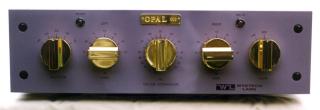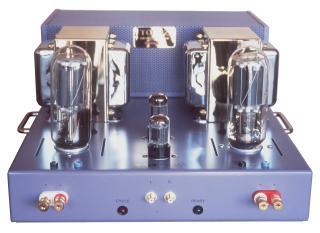Say the word "audiophile," and people picture mounds of super-hi-tech stereo equipment. For most audiophiles, though, the fewer electronics the better, and cutting-edge technology doesn't necessarily mean improved quality. And if you're willing to spend extra time and effort, good sound doesn't have to mean mounds of money, either.
In fact, if you talk to those who record jazz for a living with the audiophile market in mind, you simply need to gain an understanding of the recording and playback processes and to do some research into what's available. You could use some good, basic advice. And you'll need to do some listening.
Pierre Sprey believes five to 10 hours of listening to boom-boxes, for instance, will unearth one with close to high-end sound. "You're trading time and sweat for money," he says.
Sprey was a defense engineer before launching Mapleshade Records in 1986 on an old plantation in Maryland. There, he's captured the mastery of artists like Clifford Jordan and Hamiet Bluiett following one audiophile maxim: Every measure of control damages the sound.
That maxim is just as important in a home setup. And it's why Sprey recommends avoiding things like equalizer features and electronic volume buttons (rather than mechanical knobs) since the extra transistors become another point of signal degradation.

Mapleshade goes to great lengths to ensure a pure recording. Besides refusing the extra electronics of mixing boards, overdubs, noise reduction, compression, EQ, and reverb, Sprey makes his own wires and even turns off the air conditioner during takes to avoid the sound-muddying radio frequencies it emits.
His animated speech grows reverent when he explains what it's all for: the subtle emotion of the music conveyed by a little extra breath in the mouthpiece or an unconscious catch in a vocalist's throat things that often get lost in the recording and playback process.
In order to hear such subtleties from their home systems, Sprey advises people to do listening comparisons. "There are no theories, no numbers, no measurements that will tell you what will sound good," he says. "We achieve great sound by using the only instrument that works - our ear."
Sprey maintains that although only the really expensive brands consistently deliver good sound, you can still find quality gear from mid- to low-range companies. He gets as enthusiastic about a great deal as he does a great recording. "I found a wonderful set of Radio Shack LX4 speakers - amazing, better than studio monitors and they were closing them out for $50 and replacing them with a pale shadow of themselves. Mass-market manufacturers have no idea why they sound good when they do. It's an accident and most of the time, they don't even know it." Even if you can't find a pair of LX4s, Radio Shack can be counted on for the best cheap cabling. Sprey recommends its 18 gauge, solid-core, single-conductor wire. According to him, well-insulated wire really makes a deference.
Relax. According to three audiophile label heads, achieving hi-fidelity isn't so difficult.
When doing comparisons, Sprey suggests taking a CD that you've heard hundreds of times - something that features the instruments you like most - and using about a minute of it as your "test signal." Listen for the tone of the instruments. See if you can come up with an aural image of the stage with the piano on the left and the bass on the right, for instance, rather than a hodgepodge of sound. And whatever you're buying, make that piece of equipment the only variable.
Of course, Sprey's investigations can save you both time and money. He points to some exceptional mid-range values. In the under $300 range, Sprey raves about Sound Dynamics' RTS-3 bookshelf speakers. "They're killer. Stunningly good. They even have bass, which is amazing in a speaker that size."
In the under $700 range, Sprey points to speakers with style that matches their sound: the Ammony Gallo Acoustics Micros, which come in a soccer-ball-sized, spherical subwoofer and grapefruit-sized satellites. "They kind of disappear visually, which is another nice thing about them. They're so tiny, and they play loud. They have a 3-D spatial quality that would normally cost you $1,500 to get." In players, Sprey likes PIONEER'S DVS25 DVD player ($299), which, he says, "also happens to sound very nice playing CDs." If you want to upgrade that, get MSB Technology's Link DAC ($400) to convert the player's digital signal to anaog and you'll be squarely in the world of high-end audio."
For Samuel Rivers, head of the small but acclaimed Freedom label, the search for good sound is simpler. "Accuracy is what tickles me," he effuses from his New Jersey home. And for him, vacuum tubes rather than solid-state transistors are the only way there.
"Like beautiful women," Rivers says, referring to the way solid-state equipment dresses up the sound. "Between one who uses make-up and one who doesn't, I'll take the one who doesn't."
Accordingly his advice for getting great sound at home centers on the amplifier. And because tube electronics have long been abandoned by mainstream manufacturers, Sprey's bargain-hunting methods aren't as relevant here.
A devotee of free jazz - which until now has not often been recognized for its recording quality Rivers kept asking himself, "Why won't someone put out good music and record it properly?"
Despite his enthusiasm for tube gear, Rivers'recording technique is more than a one-trick pony. Like Mapleshade, Rivers records a live, untampered mix to two tracks, following the first rule of audiophile recording: mic sparingly for spatial realism, never to add tonal color For the spot mics, Rivers chose the wide frequency response and dynamic range of B&K, a company patronized by many audiophile labels, which also produces excellent home-audio components including receivers and amps.
For everything else, Rivers uses Esoteric Audio Research - his first choice for playback as well. Many of the British company's products (primarily amplifiers of various sorts) are designed for the exacting needs of the studio, and E.A.R. brings that professional-quality precision to its home-audio line, including the popular 834 integrated amp ($3,595).
According to Rivers, his second choice, Audio Research out of Minnesota, led the vacuum tube revival in the early'70s, when most people thought tubes had gone the way of the dinosaur Audio Research's offerings includes a full line of pre-amps and power amps complemented by a handful of CD players and D/A converters. Ranging from $1,700-17,000, Audio Research's equipment is not for the faint-of-wallet.
"If I had to buy transistor equipment, it would be Pass Labs. Nelson Pass' amps are amazing," Rivers says. Like Rivers' other favorites, Pass equipment retails between $1,800 and $16,000.
Rivers concedes that tube electronics have bloated bass, and that solid state actually measures better. "But when you listen to (solid-state), there's something missing,"
he says. "It's more artificial — and hard-sounding. Doesn't capture the harmonic integrity of the music."

Preserving harmonic integrity is equally important to Marc Rusch, chief engineer for Creative Improvised Music Projects, an audiophile label that has released 100 albums of jazz and blues in four years. Making a good recording is no secret, Rusch claims. Just make sure the musicians know the tone, timbre, and dynamic qualities of their instrument, and how to work with each other. Then, all you have to do is keep from screwing it up.
To do that, Rusch is a recording ascetic not unlike Rivers or Sprey. He limits himself to two microphones, believing it's the only way to get true stereo. He keeps the signal path as short and uncomplicated as possible, and applies minimal production to his straight-to-digital recordings. It's a risky approach. "There's no fix-it-in-the-mix safety," he says. "Either it works or it doesn't."
While it's not easy on the musicians or the engineer, it's just as demanding on the consumer. "Listeners have become so used to the practically-zero dynamic range that exists on recordings that they have to un-learn and relax to appreciate the difference." If you do, Rusch claims, you can hear the C.I.M.P difference on just about any setup. "We have listeners who get great sonic satisfaction using systems that cost anywhere from $500 to $25,000."
Still, if you want to hear what Rusch hears, grab a set of Brentworth Sound Labs' Type Three-A Speakers ($7,400) and fire 'em up with Wyetech Labs' Opal pre-amp ($8,400) and Wyetech Labs' Topaz 211A power amp ($9,800).
"We use Brenthworth speakers because they give us back the truest rendition of the timbre, tone, and dynamics of the original performance. They're very fast and true to the real-life dynamics that take place in live music.And their high efficiency and lack of crossover allow you to use better-sounding yet lower-powered amplifiers."
Rusch applies similar accolades to the amps. "Wyetech electronics have a simple signal path. All parts are hand-wired, and the units don't use any circuit boards.They simply pass through the signal that we play back, allowing us to hear all the subtle nuances that we have captured in the recording process."
"There are no theories, no numbers, no measurements that will tell you what will sound good. We achieve great sound by using the only instrument that works - our ear."
With recording only part of the equation, Rusch expects his playback equipment to follow the same hands-off, "no electronic fiddling" ethic that he applies when recording. "These companies parallel our thinking in regards to keeping the signal chain as short as possible with the least amount of electronic intrusion.The electronics are a pure class-A, single-ended design, using zero feedback."
Rusch believes that your choice of CD player has the least effect on overall sound quality."The weakness of the CD sound has more to do with the recording process than it does the playback units.That's not to say that better sounding CD players won't make a dilterence - they will - but it's far less than the difference between recordings, speakers, and amplifiers."
According to Rusch, the test of a good system is simple. "If you can find one recording in your collection that has been recorded as a true stereo recording and you can set up your system so you're getting good image specificity, depth, and all the other spatial cues, then you have done a good job of putting together a system. If the bulk of your recordings are missing this finesse, blame the recordings not your system."
It may seem like a lot of trouble to put together a home-stereo system that delivers that extra measure of realism and improved dynamics. But when carried out for the love of music, rather than its own sake -- which result in nothing but neighborhood bragging rights -- building an audiophile-class system can bring rewards worth the effort. As Rusch puts it, "Above all else, it is gratifying to hear the spirit of the music come through."